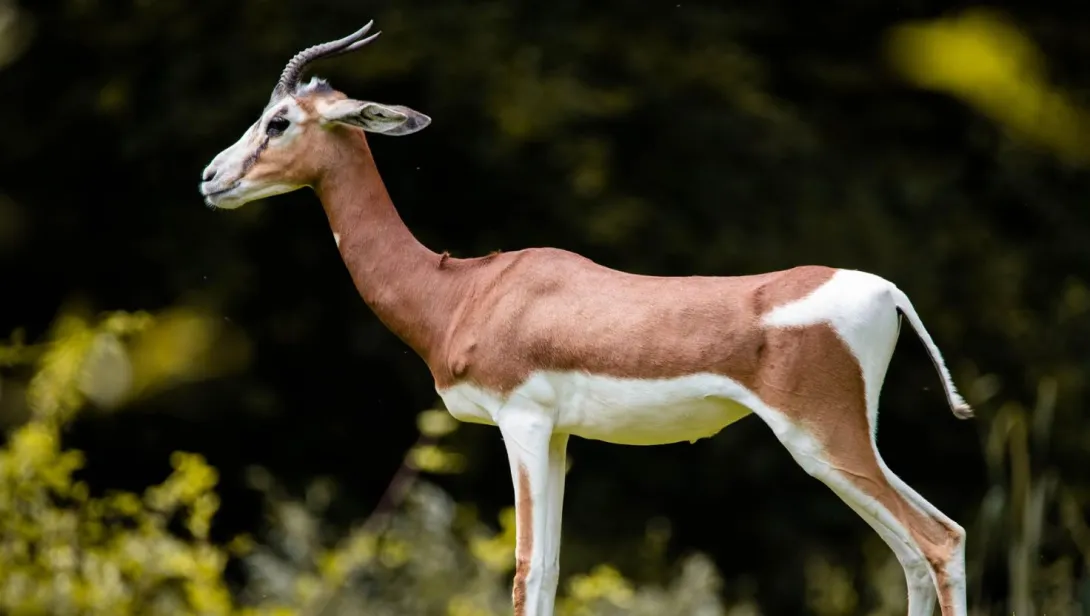Skip to main content
General Information
- The Gazelle is a species of antelope known for its graceful appearance and speed.
- Gazelles belong to the Bovidae family and the Antilopinae subfamily.
- They are primarily found in Africa, the Middle East, and parts of Asia.
- Gazelles are known for their ability to run at high speeds and perform quick, agile movements.
- There are over 19 species of gazelles, including the Thomson's gazelle, Grant's gazelle, and Dama gazelle.
Physical Characteristics
- Gazelles have a slender body with long legs, built for speed.
- They have a light brown coat with a white underbelly and distinct markings on their face and sides.
- Both males and females of some species have horns, but males generally have longer, curved horns.
- The horns are ridged and can grow up to 30–80 cm (12–31 inches) long, depending on the species.
- They have large, dark eyes that help them detect predators from a distance.
Habitat and Adaptation
- Gazelles primarily live in savannas, deserts, and open plains.
- They can survive in arid and semi-arid regions with limited water sources.
- Gazelles are highly adaptable and can go for long periods without drinking water, obtaining moisture from their food.
- They have an excellent sense of sight, hearing, and smell to detect threats.
- Their lightweight body allows them to outrun predators using speed and agility.
Diet and Feeding Behavior
- Gazelles are herbivores that primarily eat grasses, leaves, and shrubs.
- They are selective feeders and prefer fresh, nutrient-rich vegetation.
- They can adjust their diet based on seasonal changes, switching between grazing and browsing.
- Gazelles have a unique digestive system that allows them to extract maximum nutrients from low-quality food.
Social Behavior
- Gazelles are social animals that live in herds for protection.
- Herds can consist of 10 to 100 individuals, depending on the species and habitat.
- During the breeding season, males establish territories and defend them aggressively.
- Males use horn clashes to compete for dominance and mating rights.
- They communicate using vocal calls, body movements, and scent markings.
Reproduction and Lifespan
- The breeding season varies by region but usually coincides with the rainy season.
- The gestation period lasts about 5 to 6 months.
- Females give birth to a single calf, which is hidden in vegetation for protection.
- Newborns can stand and walk within an hour of birth.
- Gazelles reach maturity at around 1 to 2 years of age.
- In the wild, they have a lifespan of about 10-15 years, but they can live longer in captivity.
Predators and Defense Mechanisms
- Gazelles are preyed upon by lions, cheetahs, leopards, wild dogs, and hyenas.
- They rely on their speed and can run at 80–100 km/h (50–62 mph) to escape predators.
- Gazelles use a behavior called stotting, where they leap high into the air to confuse predators.
- They have a keen sense of awareness and stay in herds to detect danger early.
- When threatened, they use zigzag running patterns to evade attackers.
Threats and Conservation
- Many gazelle species face threats due to habitat loss, hunting, and climate change.
- Some species, such as the Dama gazelle, are critically endangered.
- Gazelles are protected in national parks and reserves to help maintain populations.
- Conservation efforts include breeding programs and reintroduction into the wild.
- Eco-tourism helps raise awareness and funds for gazelle protection.
Interesting Facts
- Gazelles are one of the fastest land animals in the world.
- They can go for days without drinking water, getting moisture from plants.
- Some gazelle species migrate seasonally in search of food and water.
- They have a specialized stomach that allows them to digest tough plant material efficiently.
- Gazelles play a key role in maintaining grassland ecosystems by controlling vegetation growth.
